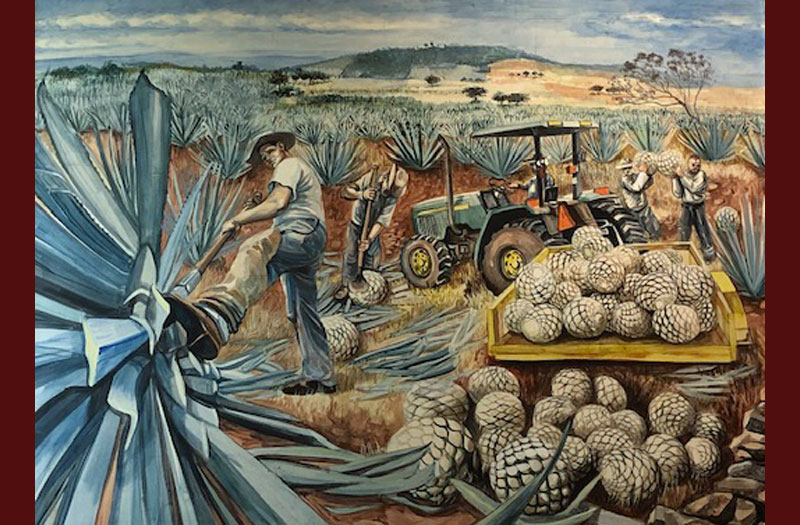The State of California used to be the state of Alta California as part of Nueva España and later Mexico. Many Mexicans stayed here – as the saying goes, ‘the border moved, not me’ – and as we’re all very aware it’s a space of intersecting and overlapping, especially Mexican, cultures. Mezcalistas
Sometimes things turn out differently than expected and result in a pleasant surprise. This is serendipity. Several years ago I was headed to Tierra del Sol, a restaurant in the family home of Lila Downs, with some Oaxacan friends. The time got away from us as we were all having too much fun! So, we chose a closer restaurant that had recently been opened by Alejandro Ruiz, the world renown Mexican chef. We first dined with Alejandro at the original location of his famous Casa Oaxaca in 2001. His first restaurant remains (by reservation only) but he has since opened a larger place with the same name a few blocks away across from the beautiful Santo Domingo Church. Paul Theroux describes eating there in his new book on Mexico:
I had lunch alone in Oaxaca at the rooftop Casa Oaxaca. A young woman at the next table, in tight jeans, flashed a smile at me, and gathering her long black hair in her pretty hand, tossed it over her shoulder and turned, bending over, so that I could see the embroidered patch on her back pocket: Eat Pray Fuck. (Paul Theroux: On the Plain of Snakes: A Mexican Journey)
Paul Theroux may not have been aware that the chica with the shocking “embroidered patch on her back packet” might have been visiting from Los Angeles. There is an area in L.A. that has been dubbed Oaxacalifornia because of the large Oaxacan population and vibrant culture that thrives there.
After the success of the larger Casa Oaxaca, Alejandro opened a more casual Casa Oaxaca Café in Colonia Reforma, a neighborhood of Oaxaca City. Ruiz has appeared on Anthony Bourdain’s show and Andrew Zimmerm’s show introducing himself to a wider audience. His most recent venture was Oaxacalifornia and we were itching to go there. The name and the logo (Mar Maiz Mezcal) are “chef Alejandro Ruiz’s interpretation of two of the best gastronomical traditions of Mexico, with spectacular ingredients from Ensenada, Baja California, and Oaxaca” and the “wine list features carefully selected Mexican wines from Baja California and the very best selection of mezcals from Oaxaca.”

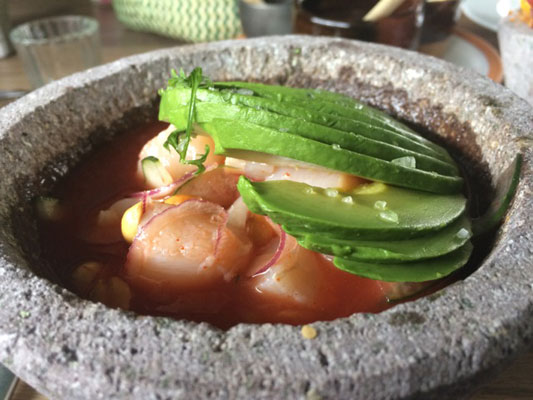
Agua Chili, Oaxacalifornia
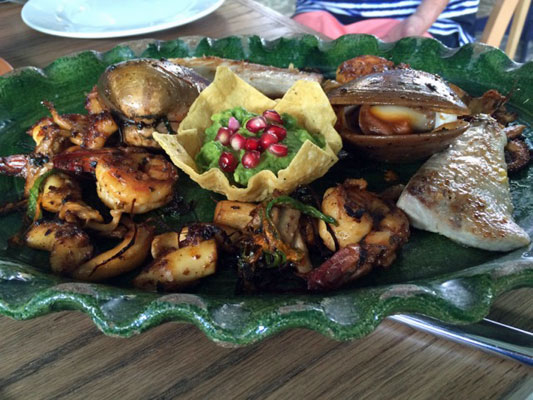
Seafood Platter, Oaxacalifornia
I mention all this not only because it brings back pleasant memories but because Oaxacalifornia resurfaced for me when I learned of another portmanteau, two words combined into one. That word is Mezcalifornia. I heard about Mezcalifornia while visiting Tlaquepaque, Mexico in the state of Jalisco. While there, I met a couple at the beautiful Casa de las Flores B&B, Craig Reynolds and Cass Sylvia, who it turns out live less than two hundred miles from my home in California (serendipity again). I was to discover that Craig was the producer of a very special agave spirit with the intriguing name Dos Volcanes. What really delighted me is that Dos Volcanes had been for sale at my local grocery store (Harvest Market) in Mendocino, California. They are temporarily out of stock. I hope they get it back in soon.
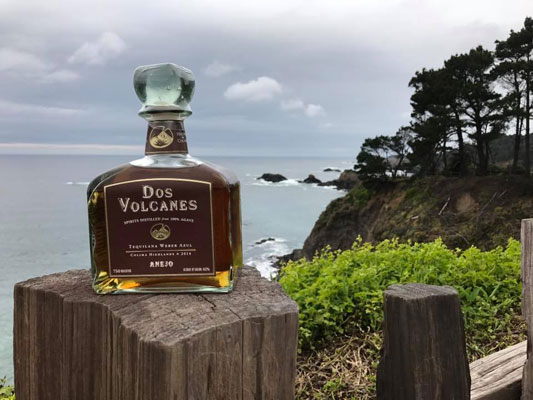
Dos Volcanes in Little River California
As we spoke, it became apparent that we had much in common. We both graduated from Stanford, we both enjoyed literature, and we both enjoyed tequila and mezcal. I was especially happy to discover that Craig through his contacts in the California State Legislature knew of some of the folks who inspired the characters in my novel Behind The Locked Door. Craig spoke to me about Project Amigo, a program close to his heart.
Thirty years ago, Reynolds began to visit the Mexican state of Colima as a volunteer with Project Amigo, a nascent program to help educate children of the small community Cofradia de Suchitlan. Underwritten largely by Rotary International, the project now also involves providing college scholarships for the community’s youths and a student dormitory at the University of Colima, Casa Amiga. Dos Volcanes flows into the Sacramento spirits scene
Reynolds explained to me how his relationship with Project Amigo led to the production of a 100% agave spirit, Dos Volcanes, originally conceived as a fundraiser for the organization. As a mezcal lover, I wondered if Dos Volcanes was a mezcal or a tequila. The answer is complicated and enlightening even for a novice like me.
The 2014 vintage of Dos Volcanes 100% agave spirits is made exclusively from one crop of blue agaves grown in the rich volcanic soil of the cool highlands of the two Colima volcanoes, Volcan de Fuego (active) and Volcan de Nevado (dormant). Our agave farm outside the remote village of Cofradia de Suchitlan, in the state of Colima, is three miles outside the official Tequila border, at the center of a region considered by historians to be the ancestral roots of modern tequilas and mezcals. Yet, because the agaves are grown outside the official five state Tequila region, we can’t call it “tequila.” We are outside the official seven state Mezcal region, so we can’t call it “mezcal” either. That’s fine with us. Every drop comes from the same crop of agaves we planted ourselves and grew without chemicals or pesticides. We processed them at a tequila distillery in Jalisco under the guidance of master distiller Ernesto Granados Cardoso. The agaves were fermented, distilled twice, proofed to 41% alcohol, then bottled with no additives. Call it whatever you like, “mezquila” if you want, as long as you enjoy this pure expression of distilled agave. Salud! Dos Volcanes
Craig, Cass and I became great friends and I vowed to learn as much as I could about Dos Volcanes. When I returned to California I promptly went out and purchased two bottles (one Blanco and one Reposado-sadly they are not yet back at Harvest Market but I’m working on that). Dos Volcanes is more like a fine tequila than a mezcal. It lacks the smoky and fiery taste so prized by mezcal lovers. But unlike most tequilas, the labels are designed to provide complete transparency like all authentic mezcals.
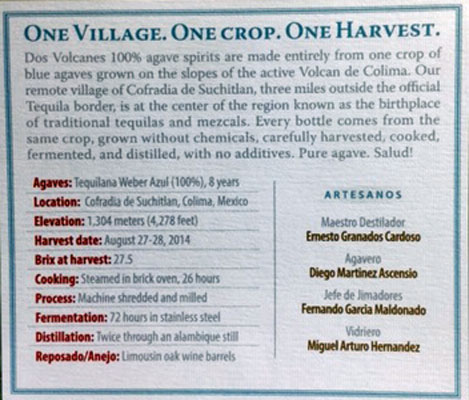
Many years ago when I decided to get serious about mezcal, I visited Mezcaloteca in Oaxaca located on Reforma Street near the Santo Domingo Church. Mezcaloteca is “dedicated to the conservation and dissemination of traditional mezcals and their biocultural processes.” It is also “a tasting room dedicated to the conservation and diffusion of mezcals and agave distillates. The agave mezcales and distillates found in Mezcaloteca come from different states of the Mexican Republic and have met all the requirements to be considered within the universe of traditional mezcales.”
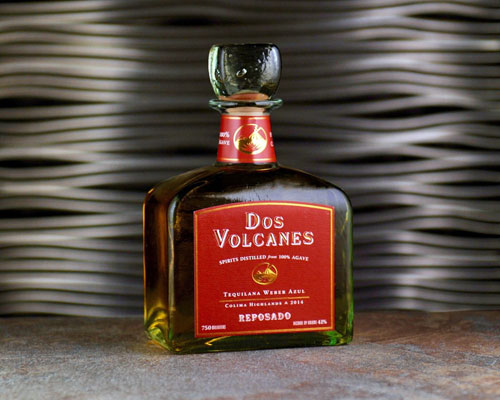
The reposado is aged 10 months in French Limousin oak that previously held California red wine.
I still have my original tasting notes and the brochures from Mezcaloteca. I am thus very impressed by the detail on the labels provided by Dos Volcanes. As I said in a previous blog: What I immediately understood at the time was that the flavor of mezcal, like wine, arises from the individual terroir: geology, soil, vegetation, topography, weather, water, and air and from the distinctive methods used by the mezcalero, the distiller, whose personal artistic style makes every mezcal unique.
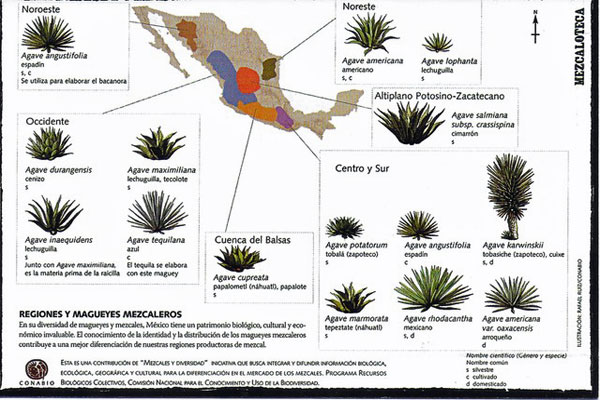
Agave regions in Mexico, Mezcaloteca
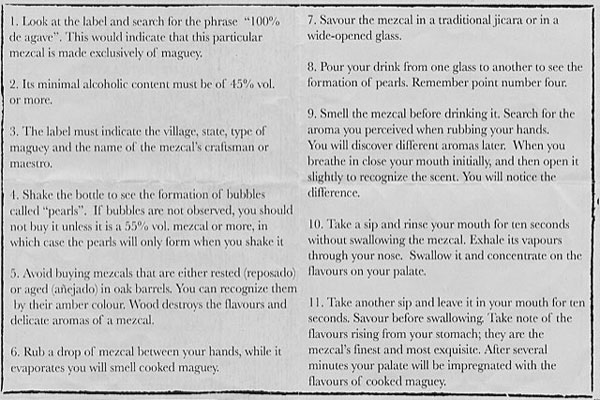
Tasting Guide to identifying traditional mezcals, Mezcaloteca
What every serious mezcal drinker knows and what I learned at Mezcaloteca is that “you don’t shoot mezcal, you sip it”. And then there are several steps you follow to identify the qualities of the mezcal. The same should be true for any quality agave spirit like Dos Volcanes.
Craft beers and artisenal wines, like mezcal, are popular with aficionados because of their unique characteristics. It’s the individual, local, personal details that matter. Dos Volcanes highlights these qualities on their labels. I remember my friend Terry made some small batches of wine in Albion, CA several years ago. When I asked he told me: Yes, I made wine from apples. Also made a small amount of wine from huckleberries. I learned to make wine from a book plus bought supplies from a wine making supply store in Berkeley. I made about 20 gallons of apple wine and it was good. Of course! The local apples and huckleberries gave his wines a special taste that was impossible to replicate anywhere else. It has always been a fact that families made their own beer and wine and even distilled spirits (moonshine). This was true in years past and it remains true today, especially in the valley and hills around Oaxaca. Craig wants to bring these traditions to California.
This sounds distinctly like any craft: It’s really about respecting the raw material, the process, and the tradition. And especially giving it time. Traditional mezcal is made this way and, despite all the craft washing out there, many craft beverages are still made with tremendous respect to the traditions that got them there. Max Garrone, Mezczlistas
“The Blanco, or unaged version, to my mind, is almost perfect. Very soft in flavor, with a characteristic lightly green, fruity scent, it has all the flavor of agave, without noticeable heat. In this sense it really is a “vino de mezcal” that could be drunk very nicely with food.” Darrell Corti, Corti Brothers, Sacramento
“So, what’s next after Dos Volcanes?” I asked Craig who recently retired as a staffer for the California State Senate having convinced several of his friends to dub Dos Volcanes the “unofficial tequila of the State Senate.”
Mezcalifornia is the venture he’s working on now and it has great potential if you think about it. He’s on the path of developing a mezcal-like agave spirit in California. With drought conditions on the rise, agave is a perfect agricultural crop if it proves feasible and profitable. Most agave plants require very little water. They also store great quantities of water which makes a field of agave plants a perfect barrier against wildfires which are increasing in California.
Of the approximately 200 total species of agaves, upward of 40 or 50 may be suitable for beverage-making. Among them is agave americana, which has been made into mezcal in Mexico and grows abundantly on, of all places, Alcatraz Island, according to Reynolds … For the past four years, Craig Reynolds has been plugging blue weber agave plants, known as agave tequilana, into three acres of soil in Yolo County, California. His hope is that when they come to maturity, they will be the source of a homegrown California agave spirit intended to rival those from Mexico. It’s a project he’s calling “Mezcalifornia.” (Welcome to Mezcalifornia)
Meeting Craig and Cass is what traveling is all about. My novel, his tequila, Project Amigo, Mezcalifornia—it’s all serendipity and the great hope is that this kind of synchroneity can change the world one sip at a time. You have to be a dreamer like Craig to get it done.. He calls his agave plants his dreamers.
Given their Mexican parentage and California roots and, perhaps, future aspirations, “I refer to my agaves as ‘Dreamers’.”
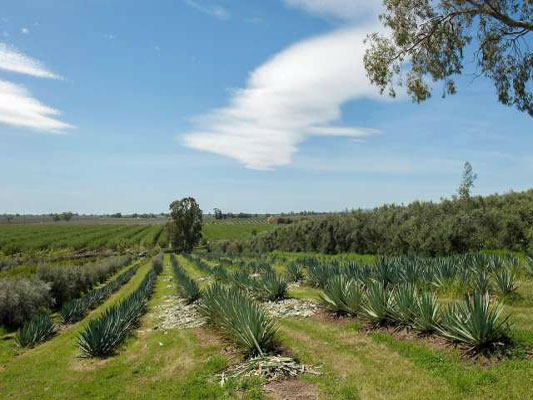
Craig Reynolds leases a part of the Muller Ranch in Woodland. He has planted blue weber agave, the variety used for Tequila production in Mexico. (courtesy of San Francisco Chronicle, photographer Anne Chadwick Williams)

